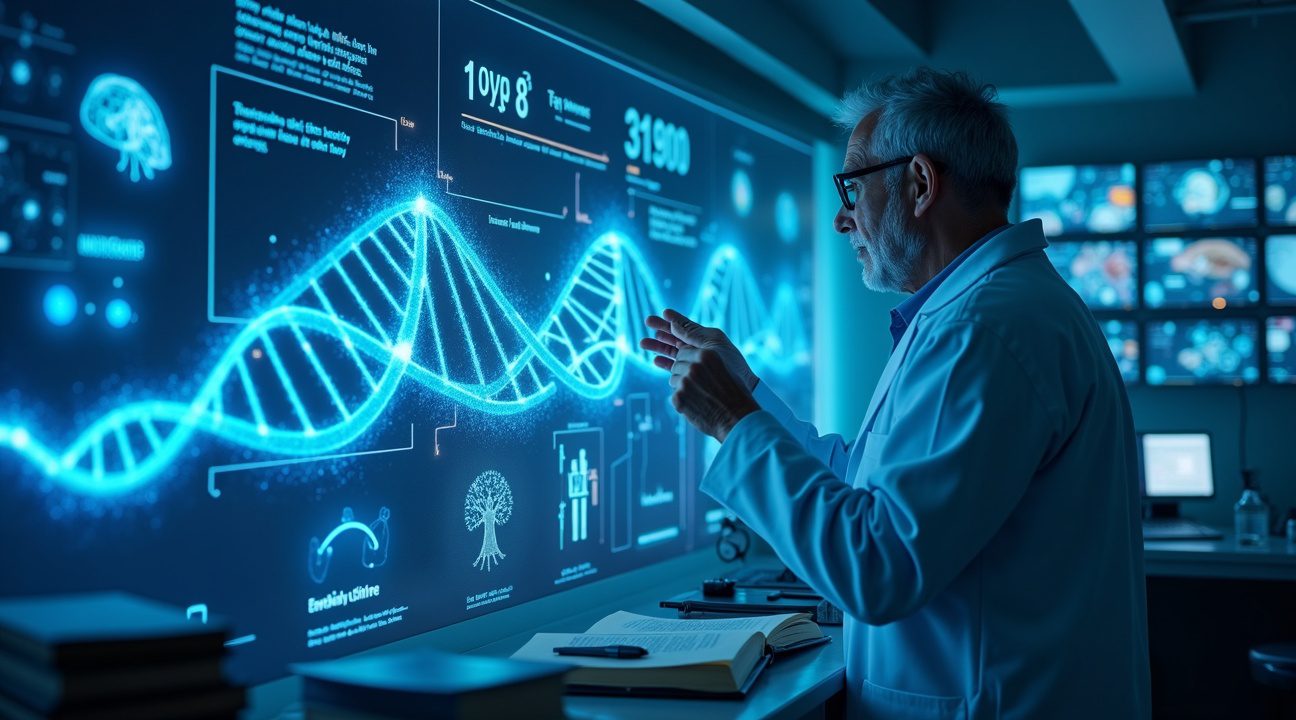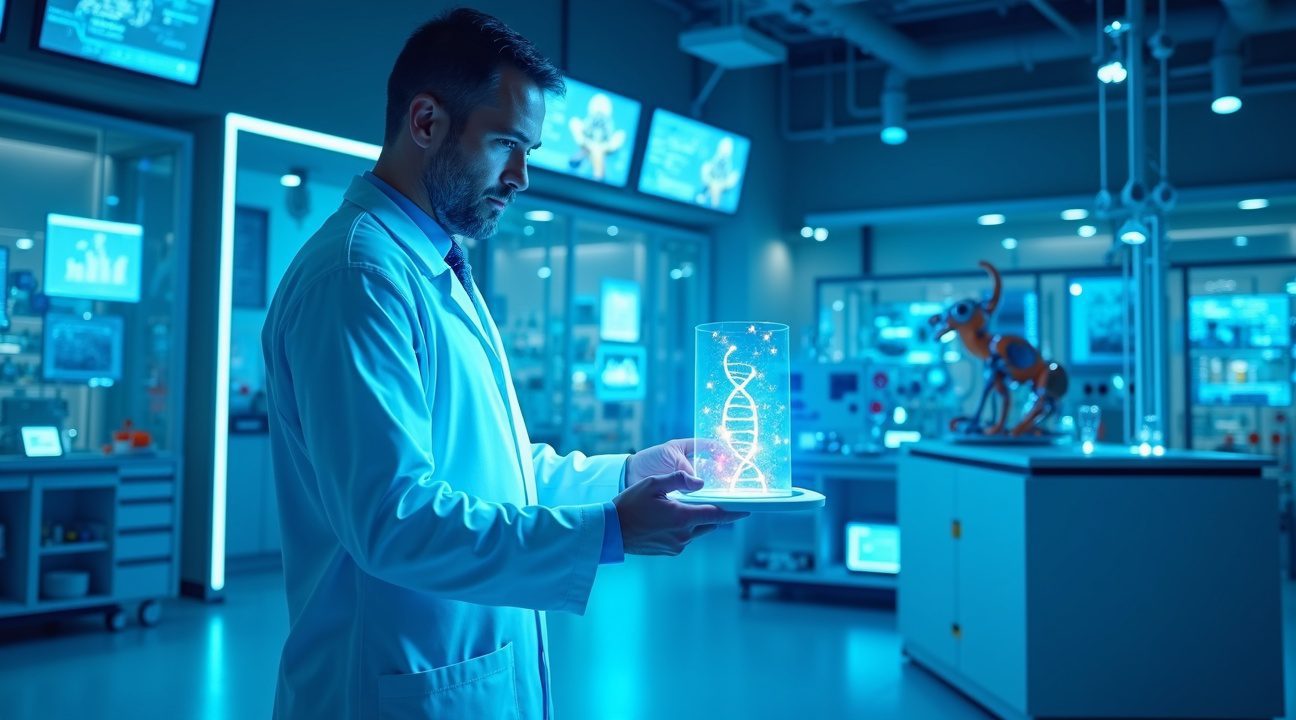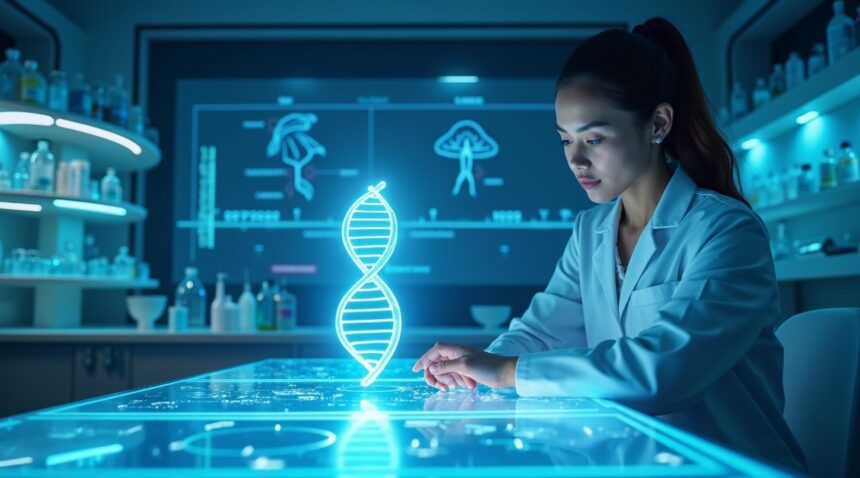Aging researchers propose that mastering DNA repair mechanisms could extend human lifespans to an extraordinary 2000 years, representing a revolutionary shift from current understanding of human longevity.
The projection remains speculative, yet recent breakthroughs in cellular repair research provide compelling evidence. Scientists have discovered key enzymes like PDI (protein disulfide isomerase) that demonstrate how dramatically enhanced DNA repair capabilities could transform how bodies combat genetic damage driving aging.
Key Takeaways
- DNA damage accumulation is the primary driver of aging – Unrepaired genetic damage persists for years in healthy cells, with blood stem cells showing damage that remains unfixed for 2-3 years. This creates a foundation for age-related decline.
- PDI enzyme discovery reveals new repair pathways – Scientists have identified protein disulfide isomerase as a crucial protein that specifically targets DNA double-strand breaks, particularly protecting non-dividing cells like neurons from genetic damage.
- Pharmaceutical interventions show promising results – Drugs like rapamycin have demonstrated the ability to triple cell survival rates after DNA damage and significantly extend lifespan in animal studies by enhancing natural repair mechanisms.
- Multiple biological systems complicate extreme longevity claims – While DNA repair enhancement shows potential, aging involves complex interactions between cellular senescence, protein aggregation, immune system decline, and metabolic dysfunction that may limit the effectiveness of DNA-focused interventions.
- Timeline for human applications remains uncertain – Despite encouraging laboratory results, the gap between animal studies and human clinical trials means that practical DNA repair therapies could take decades to develop, with 2000-year lifespans remaining speculative rather than a near-term possibility.
Could Humans Really Live 2000 Years? The DNA Repair Revolution That Has Scientists Buzzing
I’ve been following the latest discussions among aging experts, and their claims about human longevity have left me genuinely fascinated. Some researchers now suggest that perfecting DNA repair mechanisms could theoretically extend human lifespans to an extraordinary 2000 years. While this figure represents a speculative future possibility rather than an immediate reality, the science behind it deserves serious attention.
The current record for human longevity stands at 122 years, achieved by Jeanne Calment, whose remarkable lifespan continues to intrigue scientists studying the upper limits of human aging. This milestone serves as our baseline for understanding what’s naturally possible with our current biological systems.
The Vast Spectrum of Lifespans Across Species
Comparative genomic studies reveal fascinating differences in how various organisms age and survive. I find it particularly striking how laboratory models of progeroid syndromes live less than a decade, while some humans successfully cross the century mark. These dramatic variations suggest that lifespan isn’t fixed but rather depends on specific biological mechanisms that we’re only beginning to understand.
The key to unlocking extended longevity lies in DNA repair processes, which serve as our cellular maintenance crew. These mechanisms work constantly to fix damage that accumulates over time, preserving our health and delaying the decline typically associated with aging. When DNA repair systems function optimally, cells maintain their integrity longer, potentially extending both healthspan and lifespan significantly.
Current research focuses on enhancing these natural repair mechanisms rather than replacing them entirely. Scientists have identified specific genes and pathways that influence how effectively our cells can fix DNA damage. Some individuals already possess genetic variations that support exceptional longevity, providing valuable insights into how we might enhance these systems for everyone.
The 2000-year lifespan represents more than just extended time—it would fundamentally change how we think about human potential, career planning, relationships, and societal structures. While we shouldn’t expect to see such dramatic extensions in our immediate future, the underlying research continues to reveal promising pathways for meaningful longevity improvements.
Recent breakthroughs in understanding cellular aging mechanisms have already contributed to interventions that slow aging at the molecular level. These discoveries suggest that dramatically extended lifespans might not remain in the theoretical category forever, though reaching the 2000-year mark would require revolutionary advances in our DNA repair capabilities.

The Hidden Enemy: How DNA Damage Accumulates and Limits Our Lives
I find it fascinating that our bodies constantly battle an invisible enemy that slowly but surely determines how long we’ll live. DNA damage accumulates throughout our lives like tiny cracks in a foundation, gradually weakening the very structure that keeps us alive and healthy.
The Persistence Problem in Our Cells
Some forms of DNA damage remain unrepaired for years in healthy cells, creating a ticking time bomb for mutations that could lead to cancer or physiological decline. This persistence isn’t just a minor inconvenience – it’s a fundamental limitation of our biological machinery. In blood stem cells, certain damage types have been observed to persist unrepaired for two to three years, revealing the stark limitations of our natural DNA maintenance systems.
Blood stem cells represent some of our most important cellular factories, constantly producing the red and white blood cells that keep us alive. When these critical cells can’t properly repair themselves, the consequences ripple throughout our entire circulatory system. Scientists are exploring ways to enhance these repair mechanisms, but the challenge remains immense.
The Growing Burden of Accumulated Mutations
As people age, accumulated mutations increase in tissue stem cells through a phenomenon known as somatic mosaicism. This process particularly affects muscle tissue, explaining why we experience declining strength and endurance as we get older. Each damaged cell becomes a potential source of dysfunction, spreading its flawed genetic information to daughter cells during division.
The muscle tissue damage proves especially problematic because these cells must maintain incredible precision in their function. A single misfiring muscle fiber can affect an entire muscle group, and accumulated damage across multiple fibers creates the weakness and frailty associated with advanced age. Understanding this connection helps explain why exercise fights aging by potentially stimulating cellular repair mechanisms.
DNA repair serves as essential maintenance for genomic stability and plays a direct role in aging and the development of age-related diseases. Think of it as your body’s quality control department – when it functions properly, defective products get fixed or discarded. When it fails, those defects accumulate and eventually cause system-wide problems.
Research indicates that DNA repair capacity declines over time, contributing to aging phenotypes across tissues. This decline isn’t uniform – some repair systems fail faster than others, and some tissues become more vulnerable than others.
- The brain, heart, and other non-regenerating tissues face particular challenges
- These tissues cannot easily replace damaged cells
- Declining repair in these areas accelerates age-related dysfunction
I’ve observed that this declining repair capacity creates a vicious cycle. As repair systems become less efficient, more damage accumulates. The accumulated damage then interferes with the cells’ ability to maintain their repair systems, accelerating the decline. It’s like trying to fix a broken toolbox with the broken tools inside it.
The implications extend far beyond simple aging. Cancer cells often arise from accumulated DNA damage that overwhelms repair systems, while neurodegenerative diseases like Alzheimer’s may result from specific types of unrepaired genetic damage in brain cells. Even seemingly unrelated conditions like deja vu experiences might connect to cellular dysfunction caused by accumulated genetic damage.
Individual genetic variations also influence how effectively people repair DNA damage throughout their lives. Some people inherit more robust repair systems, potentially explaining why certain individuals maintain their health and vitality much longer than others. Celebrity examples of exceptional aging often highlight this genetic lottery, though lifestyle factors certainly play important roles too.
Looking to the Future
The good news lies in emerging research suggesting we might learn to enhance or restore DNA repair capacity. If scientists can develop methods to boost these natural repair systems or introduce new ones, we could potentially extend human lifespan dramatically.
- Enhancing human DNA repair capacity may reduce the onset of age-related diseases
- Genetic engineering and pharmaceutical approaches are under study
- Some experts theorize this could extend human life by centuries or more
Some researchers believe that mastering DNA repair could theoretically allow humans to live for centuries or even millennia, fundamentally changing our relationship with mortality itself.
https://www.youtube.com/watch?v=Cm7d5py2GiE
Breakthrough Discovery: The Protein That Could Hold the Key to Longer Life
I’ve watched scientists uncover countless potential solutions for aging, but few discoveries have excited me as much as the recent identification of PDI (protein disulfide isomerase) as a crucial player in DNA repair. This enzyme, previously known only for its role in protein folding, has emerged as a powerful guardian against the genetic damage that drives aging—particularly in our brains.
How PDI Transforms DNA Repair in Aging Cells
PDI works by specifically targeting DNA double-strand breaks, which represent some of the most dangerous forms of genetic damage our cells face. I find it fascinating that researchers discovered this enzyme’s hidden talent almost by accident while studying protein folding mechanisms. When scientists removed PDI from cells, they watched DNA repair capabilities plummet dramatically. However, the story gets even more interesting when they reintroduced the enzyme.
The restoration of DNA repair function depends entirely on PDI maintaining its specific cysteine residues—molecular components essential for the enzyme’s redox activity. Without these intact residues, PDI loses its ability to fix genetic damage, even when present in adequate quantities. This discovery represents a major step forward in understanding potential treatments to slow aging at the cellular level.
PDI’s impact becomes particularly significant in non-dividing cells like neurons. Unlike other cells that can replace themselves through division, neurons must survive for decades while accumulating genetic damage over time. I consider this one of the primary reasons why brain health deteriorates with age—neurons simply can’t repair themselves as effectively as younger cells.
The enzyme’s protective function extends beyond basic DNA repair. PDI actively shields neurons from the type of genetic damage that leads to cognitive decline and neurological disorders. This protection mechanism works continuously in healthy brains, but its efficiency decreases as we age or when the enzyme becomes damaged.
Research shows that PDI levels naturally decline with age, creating a vicious cycle where reduced enzyme availability leads to more genetic damage, which further impairs cellular repair mechanisms. Breaking this cycle could potentially extend healthy brain function far beyond current limitations.
Scientists now view PDI and similar enzymes as promising targets for anti-aging therapies. The enzyme’s dual role in protein folding and DNA repair makes it an attractive candidate for interventions aimed at preventing age-related cognitive decline. I believe this discovery could revolutionize how we approach brain health in aging populations.
The implications extend beyond just preventing disease. If researchers can enhance PDI function or develop synthetic alternatives, they might be able to maintain cognitive performance at youthful levels well into advanced age. This approach differs from traditional anti-aging strategies by addressing genetic damage directly rather than treating symptoms after they appear.
Current research focuses on identifying ways to boost PDI activity or protect existing enzymes from age-related damage. Some scientists explore:
- Dietary interventions that support the enzyme’s function
- Pharmaceutical approaches to enhance its activity
I expect these efforts to yield practical applications within the next decade.
The discovery also raises intriguing questions about other enzymes that might have similar hidden functions. PDI’s unexpected role in DNA repair suggests that our understanding of cellular maintenance mechanisms remains incomplete. Future research will likely uncover additional proteins with dual roles in aging prevention.
Understanding PDI’s mechanism provides crucial insights into why some people age more gracefully than others. Genetic variations affecting PDI function could explain differences in cognitive aging patterns between individuals. This knowledge might eventually enable personalized anti-aging strategies based on individual enzyme profiles.
The enzyme’s importance in non-dividing cells makes it particularly relevant for fighting aging in tissues that can’t replace themselves. Beyond neurons, PDI likely plays similar protective roles in heart muscle, skeletal muscle, and other long-lived cell types that accumulate damage over time.
From Lab to Life: Drugs and Therapies That Could Supercharge Our DNA Repair
Scientists are making remarkable progress in developing treatments that could dramatically boost our body’s ability to repair DNA damage. Rapamycin stands out as one of the most promising compounds in this field, originally created to prevent organ rejection after transplants.
This powerful drug has demonstrated incredible protective effects on DNA within immune cells, effectively reducing biological aging markers that typically accumulate over time. Laboratory studies reveal that rapamycin can triple cell survival rates after DNA damage occurs, suggesting its potential to help our bodies bounce back from the molecular wear and tear that drives aging.
Breakthrough Approaches to DNA Enhancement
Researchers are pursuing multiple strategies to amplify our natural DNA repair capabilities:
- Genetic modification techniques that enhance specific repair enzymes
- Pharmaceutical agents like rapamycin that protect cellular machinery
- Combination therapies targeting multiple DNA repair pathways simultaneously
- Compounds that activate dormant repair mechanisms already present in our cells
These interventions work by strengthening the cellular processes responsible for fixing DNA breaks, correcting mutations, and maintaining chromosomal integrity. Animal studies consistently show that enhancing these repair mechanisms leads to significant improvements in both lifespan and healthspan — the number of years lived in good health.
The concept behind these treatments involves ‘supercharging’ pathways that already exist within our cells. Rather than replacing natural systems, these therapies amplify what our bodies already do, potentially making repair processes more efficient and comprehensive than they would be naturally.
Laboratory results continue to astound researchers, with some animals showing dramatic life extension when their DNA repair systems receive pharmaceutical support. These findings have sparked intense interest in translating similar benefits to human applications, though significant challenges remain.
Current research focuses on understanding how different repair pathways interact and which combinations of interventions might produce the most substantial benefits. Scientists are particularly interested in treatments that could address multiple types of DNA damage simultaneously, as aging involves various forms of molecular deterioration.
The transition from laboratory success to human application represents a major hurdle in this field. While animal models provide valuable insights, human biology presents unique complexities that don’t always mirror results seen in mice or other test subjects. Clinical trials must demonstrate both safety and efficacy before any DNA repair therapy becomes available to the general public.
Regulatory agencies require extensive testing to ensure these interventions don’t produce unintended consequences. Scientists must prove that enhancing DNA repair won’t interfere with normal cellular functions or create new health risks. This careful approach means that promising treatments may take years or even decades to reach patients.
Despite these challenges, researchers remain optimistic about the potential for DNA repair enhancement to transform human longevity. Some experts believe that breakthrough treatments could emerge within the next few decades, potentially extending healthy human lifespan far beyond current limits.
The gap between animal studies and human trials continues to narrow as our understanding of DNA repair mechanisms deepens. Advances in genetic engineering and pharmaceutical development provide new tools for creating more targeted and effective interventions.
Several biotech companies are now investing heavily in DNA repair research, recognizing the enormous potential market for effective anti-aging therapies. This commercial interest helps drive funding for clinical trials and accelerates the development timeline for bringing these treatments to market.
Early-phase human studies are beginning to explore how DNA repair enhancement might work in practice, though results remain preliminary. These initial trials focus primarily on safety, establishing dosing protocols, and identifying potential side effects before moving to larger efficacy studies.
The promise of dramatically extended human lifespan through enhanced DNA repair represents one of the most exciting frontiers in modern medicine, even as researchers work to bridge the substantial gap between laboratory promise and clinical reality.

The Reality Check: Why 2000 Years Might Be Pure Science Fiction
While DNA repair enhancement presents exciting possibilities for extending human lifespan, the scientific community remains divided on whether this approach could realistically support centuries-long lives. The biological mechanisms that govern aging operate through multiple interconnected pathways, making it unlikely that DNA repair alone holds the key to dramatic life extension.
Current research reveals significant gaps in our understanding of how DNA repair dysfunctions affect different individuals. Not all forms of DNA repair problems produce identical aging patterns across people or diseases. This variation suggests that aging involves far more complex biological processes than simple DNA degradation. Scientists continue to debate whether improving DNA repair would enhance overall metabolic function or simply reduce cancer-causing mutations.
The Limits of Current Scientific Knowledge
The relationship between telomere shortening and aging doesn’t follow predictable patterns across all premature aging syndromes. Some individuals with genetic conditions affecting DNA repair show severe aging symptoms early in life, while others maintain relatively normal lifespans despite similar genetic defects. This inconsistency challenges the assumption that perfecting DNA repair mechanisms would automatically translate to extreme longevity.
Several critical factors remain unresolved in longevity research:
- Cellular senescence occurs through multiple pathways beyond DNA damage
- Protein aggregation and metabolic dysfunction contribute independently to aging
- Immune system decline appears linked to factors separate from DNA repair capacity
- Organ system interdependencies create complex failure patterns that DNA repair might not address
Research into aging treatments suggests that multiple interventions working together might prove more effective than focusing solely on DNA repair. Studies examining whether exercise fights aging demonstrate that lifestyle factors interact with genetic repair mechanisms in ways scientists don’t fully understand yet.
The speculation surrounding 2000-year lifespans lacks solid experimental foundation. Most research supporting extreme life extension relies on theoretical models rather than demonstrated results in complex organisms. Even successful DNA repair enhancement in laboratory settings hasn’t produced the dramatic lifespan increases that would support such ambitious projections.
Human-centered research remains critically underdeveloped compared to studies in simpler organisms. The biological complexity of human aging involves intricate interactions between genetics, environment, and cellular processes that laboratory models can’t fully replicate. Scientists need extensive human trials to determine whether DNA repair enhancement would deliver meaningful longevity benefits or primarily reduce specific disease risks like cancer.
Until researchers develop more comprehensive understanding of aging mechanisms and conduct rigorous human studies, claims about millennial lifespans remain firmly in the territory of science fiction rather than scientific fact.
What This Means for the Future of Human Aging
Understanding DNA repair mechanisms represents a fundamental shift in how scientists approach the aging process. The research focuses heavily on non-homologous end joining and the repair of double-strand breaks, two critical pathways that maintain genetic integrity throughout human life. These mechanisms serve as the body’s primary defense against the accumulation of mutations that drive cellular deterioration and age-related diseases.
The evidence for DNA repair’s importance becomes clear when examining the extremes of human lifespan. Individuals with progeroid syndromes often don’t survive beyond their teenage years due to accelerated aging caused by defective DNA repair systems. Conversely, supercentenarians who live beyond 100 years typically possess highly efficient repair mechanisms that protect their genetic material from damage. This stark contrast demonstrates how DNA repair capability directly influences maximum human lifespan potential.
The Science Behind Mutation Accumulation and Tissue Aging
Mutation accumulation affects different parts of the body at varying rates, with high-turnover tissues like muscle showing particular vulnerability to genetic damage. The somatic genome – the DNA in non-reproductive cells – bears the brunt of environmental stressors, radiation exposure, and metabolic byproducts throughout a person’s lifetime. Scientists have observed that tissues requiring constant regeneration accumulate mutations faster than more stable cell populations, explaining why muscle mass and function decline more rapidly with age.
Current research suggests that enhancing these natural repair processes could dramatically extend both lifespan and healthspan. Rapamycin, originally developed as an immunosuppressive drug, has shown promising results in extending lifespan across multiple species by influencing cellular repair mechanisms. Studies indicate this compound affects the body’s ability to maintain DNA integrity while simultaneously reducing inflammation and cellular stress.
Future enzyme modulators represent the next frontier in DNA repair enhancement. These targeted therapies aim to boost specific repair pathways that become less efficient with age. Scientists are developing compounds that can activate dormant repair genes or enhance the activity of existing repair enzymes. Early laboratory results suggest these interventions could significantly slow the aging process at the cellular level.
The implications extend far beyond simply adding years to life. Enhanced DNA repair could prevent age-related diseases like cancer, cardiovascular disease, and neurodegeneration before they develop. This approach addresses aging at its root cause rather than treating symptoms after damage has occurred. New breakthrough treatments continue to emerge from laboratories worldwide, each bringing humanity closer to meaningful life extension.
Longevity research has also revealed that exercise fights aging through its effects on DNA repair mechanisms. Physical activity stimulates the production of repair enzymes and reduces oxidative stress that damages genetic material. This finding supports the development of exercise-based interventions alongside pharmaceutical approaches.
The timeline for these therapies remains uncertain, but progress accelerates as researchers better understand the molecular basis of aging. Clinical trials for DNA repair enhancers are beginning to show results in animal models, with human trials expected within the next decade. These studies will determine whether the theoretical benefits of enhanced DNA repair translate into practical life extension therapies.
The potential to reach ages approaching 2000 years may sound fantastical, but the underlying science suggests such longevity could become achievable through sufficiently advanced DNA repair enhancement. Current research focuses on identifying the most effective repair pathways to target and developing delivery methods that can reach all body tissues effectively.
Human aging research continues to evolve rapidly, with each discovery bringing new possibilities for extending healthy lifespan. The combination of pharmaceutical interventions, lifestyle modifications, and emerging genetic therapies creates multiple pathways for achieving unprecedented longevity through improved DNA repair mechanisms.
Sources:
Decoding DNA repair regulation across human lifespan variability, published in PubMed/Elsevier (2025)
Could Targeting This Enzyme Slow Aging? Scientists Reveal PDI’s Role in DNA Repair, Cosmetics & Toiletries
Slowing down aging, one DNA strand at a time, Earth.com
Targeting DNA damage in ageing: towards supercharging DNA repair, Springer Nature Limited (2025)
DNA damage can last unrepaired for years, changing our view of mutations, Wellcome Trust Sanger Institute, ScienceDaily (2025)
An Example of DNA Repair Deficiency Accelerating Muscle Aging, Fight Aging!
New Research Finds Telomere Shortening Not Consistent Across Premature Aging Disorders, Aging-US


